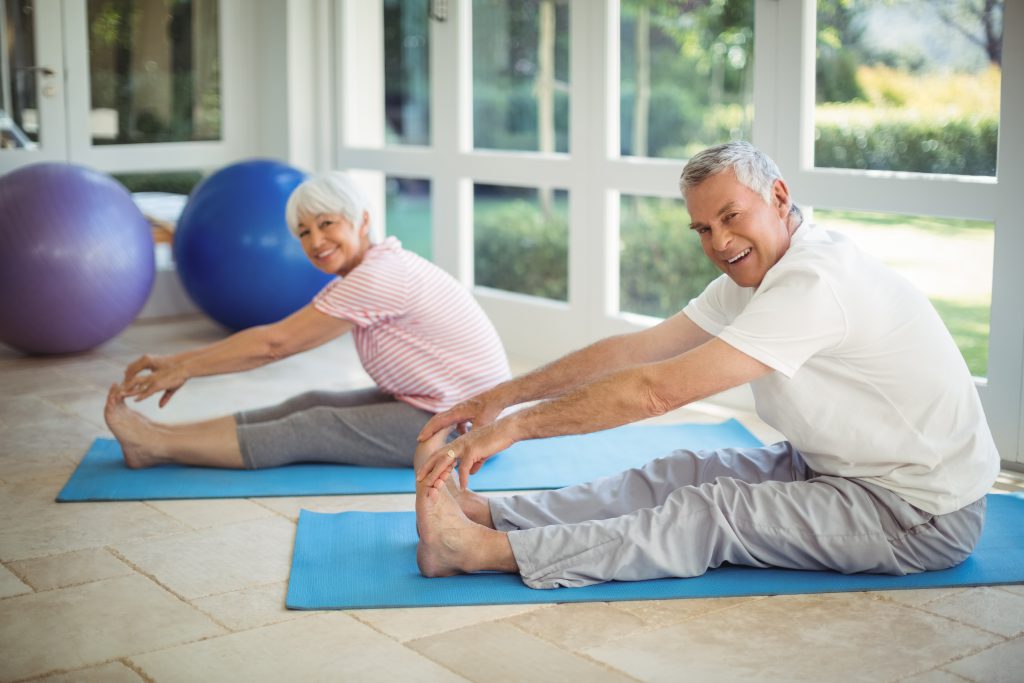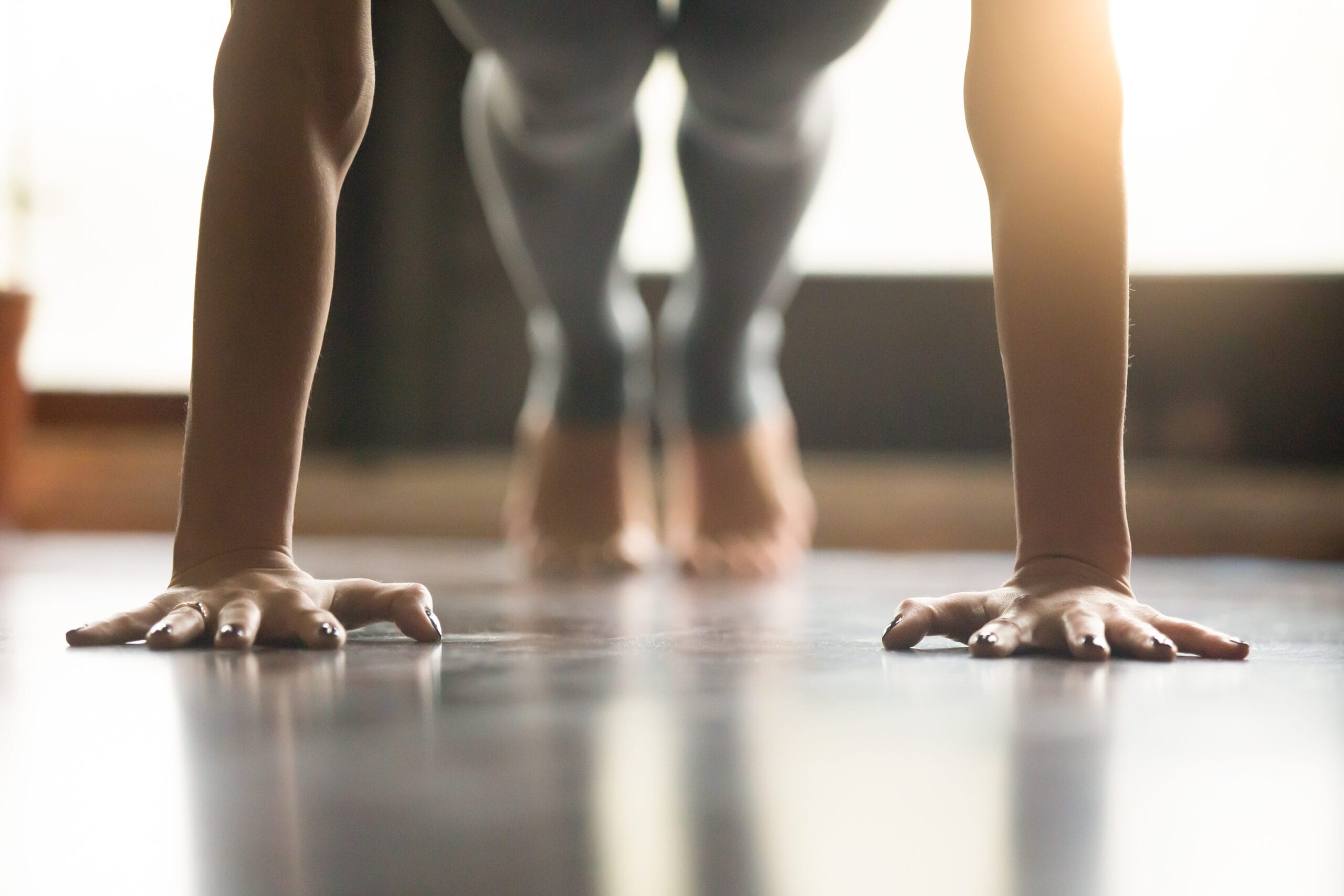
The best stretching exercises for seniors are ones that are safe to perform and are going to provide the most benefit. As a geriatric physical therapist, this topic hits close to my heart. I spend my days teaching seniors exercises to help them regain function or decrease pain. Many times, these exercises include stretches because they are an essential part of improving fitness and overall mobility.
I know I’m walking a thin line between fitness and rehab with this topic. But I think it’s an important subject to discuss, so I’m going for it. I’m going to do my best to keep it relevant to exercising at home (and not turn into an all out therapy article).
I also know there are a lot of seniors exercising in their own home gyms out there that are not involved in any type of rehab. If incorporating a few key stretches into your routine can make you a little safer and make you less likely to get injured during your workouts, I think it’s worth a shot.
The goal of this article is to provide you with 5 stretches I think will be a great addition to your regular routine, as well as make you a little more durable in the real world.
Why Is Stretching Important?
Stretching should be an important part of all of our fitness routines. Unfortunately, I think it’s usually the first thing to go out the window. And trust me, I understand why. I’ve never enjoyed stretching. I will even admit that I, as a therapist, don’t stretch nearly as much now as I should. But, it’s a work in progress.
But why should we be stretching in the first place?
We need to stretch in order to maintain our range of motion (ROM). Ever heard the ol saying, “if you don’t use it, you lose it”? Of course you have, we all have. If we don’t use our muscles regularly, they become weak. Unfortunately, the same is true with stretching- if we don’t stretch regularly, our muscles become tight.
When muscles become tight, we lose the ability to move our joints freely. The hamstrings is a great example, because so many of us, young and old, have tight hamstrings. When your hamstrings become tight, you lose the ability to bend down and touch your toes.
If they are really tight, you lose the ability to fully straighten your knee when sitting in a chair. This same principle can be applied to any muscle in our body. Tight back muscles can limit spinal mobility. Tight hip muscles can limit hip mobility. And so on.
According to the Harvard, tight muscles are also more likely to become injured during exercise. If you try (or accidentally) stretch your tight muscle past its range, you are likely going to experience a muscle strain, or worse.
Tight muscles can also cause pain without a muscle strain or tear. I see this all the time. Muscles are a big source of pain for all of us- stretching is a great way to decrease that pain and make the odds of it returning less likely.
Why Do Muscles Become Tight?
I mentioned briefly above that muscles become tight when they aren’t stretched. But why? It’s really due to the fact that our muscles are really good at adapting to whatever situation we put them in.
If we exercise and lift weights regularly, our muscles become stronger. That is, our muscles adapt to the load they are being put under. When we lift weights, if the load is sufficient enough, we cause micro tears in the muscle fibers. Our body repairs these fibers. The result is a muscle that is a little stronger than it was before.
This is why we exercise- to stay strong, fit, and healthy.
A big problem a lot of us have, especially as we age, is that we move less. We spend a lot of our time sitting in the same positions and postures. Our muscles get used to these positions and adapt to fit them. The results are muscles that have shortened.
Why do so many of us have tight hamstrings? Because a lot of us spend a lot of time sitting! Driving, working in front of a desk, watching tv. These sitting postures put our hamstrings in a flexed (or bent) position. The result are tight hamstrings that don’t like to stretch out.
Luckily, our muscles are smart and can learn new tricks, regardless of how old they are! Folks of any age can improve health and well being with the help of stretching.
Not all stretches are appropriate for all seniors. Before trying anything new, it’s a good idea to consult your physician or local physical therapist.
The 5 Best Stretching Exercises For Seniors
Tip #1: The whole “no-pain, no-gain” rule isn’t true! You shouldn’t be feeling pain with any of these stretches. You should feel a stretch, this can be a little uncomfortable, but it should not hurt! If any of these stretches cause pain, please stop.
Tip #2: These stretches are designed for relatively healthy seniors. If you have any joint replacements, pain, or other limitations, please be careful and always abide by any precautions you may have. When in doubt, consult your physician. Remember, any stretch can be modified.
It’s also a good idea to warm up a little before stretching. You could walk or march in place for a few minutes. If you have an exercise bike or treadmill that would work well as a quick warm up before stretching.
#1 Hamstring Stretch
There are a hundred different ways to stretch your hamstrings. I like the standing version shown here by propping one leg up on a chair, it’s pretty gentle on your back.
Stretching your hamstrings is important because it can reduce your chances of injuring your knees and back during exercise. Stretching your hamstrings can also help alleviate back pain, depending on what’s causing it.
Try to keep the knee on the chair as straight as possible. Lean forward from the pelvis (instead of bending forward from the back) and you will feel more of a stretch.
The second stretch shown is also a great, safe way to stretch your hamstrings.
#2 Glute/Piriformis Stretch
Stretching out the back of the hip (glutes/piriformis) is another smart move. Not only is it going to make you feel looser and move more comfortably, but it’s a great way to prevent back and SI joint pain.
All of us, regardless of age, should be doing this stretch! If you have sciatica, or have had it in the past, this is a great stretch to relieve pressure on the sciatic nerve.
For this stretch, you are going to lie flat on the floor or bed, and bend one knee toward your opposite shoulder. You should feel the stretch in the back of your hip.
The second stretch shown here is a nice variation if it’s uncomfortable on your hip to bring it toward your opposite shoulder. Sometimes that position is a little pinchy on the hip joint.
#3 Standing Hip Flexor Stretch
We always think about the hamstrings getting tight from sitting for long periods of time during the day. Guess what also gets tight from doing this… our hip flexors. These are the group of muscles located in the front of our hips. Most of our hip flexors also attach to the front of our lumbar spine.
So guess what can happen when you have tight hip flexors? You guessed it, low back pain.
There are several different ways to stretch this muscle group out. All variations have one thing in common though, hip extension. I like the standing version because it’s pretty comfortable and easy to do anywhere.
For this stretch, you are going to take a large step forward, keeping the back leg straight (similar to a lunge position). Bend the front knee slightly. Try to keep your trunk up nice and tall as you gently lunge forward.
You should feel the stretch in the front of your hip (of the back leg). You may also feel it a little in your abdomen. Feel free to hold onto a chair or wall for balance on this one.
I like how she shows the option of bringing your arm overhead for added stretch. As well as taking a bigger step for more stretch.
#4 Chest Stretch
Stretching out or chest muscles, or pecs, is important for posture. A lot of us become tight in our pecs and weak in our upper back muscles. The result is a hunched over posture that no one wants. Having tight chest muscles also make you more likely to suffer from shoulder pain (impingement) during exercises like bench press or shoulder press.
For this exercise you are going to knee a doorway or wall. Place your arm on the doorframe with your elbow bent to 90 deg and arm at about shoulder height. Gently lunge forward until you feel a nice stretch in your chest.
If this stretch is uncomfortable for your shoulder, decrease the height of your arm. Play with the starting height until you find a comfortable position.
The gentleman in this video does a great job demonstrating and talking you through how to set up correctly.
#5 Posterior Shoulder Stretch
The last stretch on our list today is for the back of your shoulder. We just stretched the front of our chest, now it’s time to take care of the back of our arms.
This is an important part of our body to stretch because there is a lot going on back here. Between the deltoid, the rotator cuff muscles, and a few nerves, there’s a lot that can get irritated.
Most of us are also tight behind the shoulders. Being tight back here can affect the way your shoulder moves and make you more susceptible to shoulder injury during your workouts.
I like this stretch because it can be done anywhere, sitting or standing. Keeping your elbow as straight as possible, bring your arm across your body. Gently pull across with your opposite arm. Start at about shoulder height, but adjust your angle as needed to feel the stretch behind your shoulder.
I hate to call out a fellow PT, but technically there are 4 rotator cuff muscles…just saying. Maybe he wasn’t counting the subscapularis because it isn’t stretched with this move?
I also like to pull right above the elbow for a better stretch.
How Long Should I Hold Each Stretch?
Great question. If you ask 5 different people, you’ll probably get 5 different answers. I’m off the opinion that if we want to realistically include stretching into our everyday workouts, we need to make the stretching program as doable as possible.
For healthy seniors, I think a good goal is to hold each stretch for 30 sec, and to do each stretch 2x for each side.
And you should alternate sides. Let’s use the hamstring stretch as an example: stretch your right hamstring for 30 seconds, switch over and do the left side for 30 seconds, now switch back to the right for 30 more seconds, then finish with one more 30 second stretch on the left.
We can write this as “2 x 30 sec” for each side, on each exercise. And don’t worry about timing yourself with a watch or anything like that. Simply count to “30” to yourself and switch sides. Odds are it will actually be shorter than 30 real seconds, but that’s ok.
Time for a little math:
- 2 x 30 sec = 1 min for each side
- 1 min/side x 2 sides = 2 minutes for each exercise
- 2 min/exercise x 5 exercises = 10 total min of stretching exercises
So, if you actually held each move for 30 sec, it would take you 10 minutes to perform this stretching routine. Not too bad. In reality, it would probably take you 6-8 minutes.
I want to reiterate that these stretches and hold times are for healthy seniors without any significant musculoskeletal problems or joint pain. These exercises are also not intended for rehabilitation of anything. Stretching for rehab is different, with different doses and holds.
Should I Stretch Before of After My Workout?
Another good question. Personally, I like to do a little before and after I exercise. It’s really up to you. If you stretch before your workout, make sure you warm up a little before you start stretching. Get the blood pumping and the muscles warm before you start pulling on them. Last thing you want is to hurt yourself stretching before your workout!
Also make sure you don’t stretch too much before your workout, because that can actually increase your chances of injury.
You know, you could split up the stretch routine and do half before and half after your workout. Perform 1 set of 30 sec for each stretch before you workout, and then another set of each stretch afterwards. This would be a great way to cool down after your workout.
Final Thoughts
Stretching is important for all of us because we all get tight muscles. Stretching is especially important for seniors because our older population is more likely to feel the consequences of these tight muscles. Having muscle tightness as we age can make mobility more difficult and make us more prone to injury during our everyday tasks and workouts.
You don’t have to be a yogi to feel the benefits of stretching. Including stretches into your daily workouts will make a difference. But it does take time. Stretching once a week isn’t going to cut it- in order to improve flexibility you have to stretch consistently.
Like all exercise, it takes time to notice improvement. Stick with it and you can get more flexible and reduce your chances of injury.
And we saw that it doesn’t have to take half an hour to stretch either. 6-8 minutes is all it takes. Make it part of your normal workout routine and you will get used to it.
There are plenty of other great stretches out there, but I think these are the 5 best stretching exercises seniors can do today to improve flexibility and reduce chance of injury during exercise. With these, we’re hitting some of the larger muscles in our bodies: the hamstrings, glutes, hip flexors, pecs, and posterior shoulder.
If you have any questions about the above stretches, please don’t hesitate to ask. All of these stretches can be modified. Just leave a comment or email me.
Now time to get stretching!



Thank you Will for sharing. This article was very helpful, as I am 55 years old and suffer from sciatica. I will definitely incorporate these moves into my routine.
I’m glad you found it helpful, I hope stretching helps with your sciatica. Good luck!